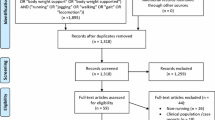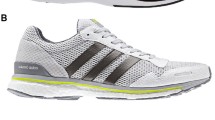Summary
The low impact nature of exercise in the water has increased interest in this form of exercise and specifically in water running as a cross-training modality. It is used as a possible preventative and therapeutic modality for rehabilitation. The high impact nature of land running predisposes the runner to stress of the lower limbs and overuse injuries. The need to reduce impact, as well as provide a low impact or non-weight-bearing condition for rehabilitation, has led runners and their coaches to the water. This increased interest by coaches and their athletes, attending sports medicine physicians and rehabilitative professionals has stimulated research into water immersion to the neck (WI) running.
Exercise in the water has long been used by rehabilitative professionals with patients who have physically debilitating conditions (i.e. arthritis, musculoskeletal disorders) as it provides a medium for even those with limited mobility to exercise and relax their muscles. Numerous comparative studies into WI running from a metabolic as well as a training perspective have been published. WI has also long been used to simulate weightlessness for the comparative study of cardiorespiratory function and thermoregulation. WI and the associated cephalad shift in blood volume has implications on exercise responses during WI running exercise. In addition, the non-weight-bearing nature of WI running also raises issues of the cross-training benefits of WI running. WI running style and prior familiarity with the activity have been found to have a direct relationship with the comparability of WI to land running. This review presents current research into WI running, training specificity and comparative physiology.
Similar content being viewed by others
References
Morlock JF, Dressendorfer RH. Modification of a standard bicycle ergometer for underwater use. Undersea Biomed Res 1974; 1: 335–42
Christie JL, Sheldahl LM, Tristani FE, et al. Cardiovascular regulation during head-out water immersion exercise. J Appl Physiol 1990; 69: 657–64
Connelly TP, Sheldahl LM, Tristani FE, et al. Effect of increased central blood volume with water immersion on plasma catecholamines during exercise. J Appl Physiol 1990; 69: 651–6
Sheldahl LM, Tristani FE, Clifford PS, et al. Effect of head-out water immersion on cardiorespiratory response to dynamic exercise. J Am Coll Cardiol 1987; 10(6): 1254–8
Sheldahl LM, Wann LS, Clifford P, et al. Effects of central hypervolemia on cardiac performance during exercise. J Appl Physiol 1984; 57: 1662–7
Dressendorfer RH, Morlock JF, Bakar DG, et al. Effects of head-out water immersion on cardiorespiratory responses to maximal cycling exercise. Undersea Biomed Res 1976; 3(3): 177–87
Frangolias DD, Rhodes EC. Maximal and ventilatory threshold responses to treadmill and water immersion running. Med Sci Sport Exerc 1995; 27(7): 1007–13
Mercer JA, Jensen RL, Fromme CF. 1994 Prediction of exercise prescription from deep water running based on treadmill running [abstract]. Med Sci Sport Exerc 1994; 26: S10
Svedenhag J, Seger J. Running on land and in water: comparative exercise physiology. Med Sci Sport Exerc 1992; 24: 1155–60
Town GP, Bradley SS. Maximal metabolic responses of deep and shallow water running in trained runners. Med Sci Sport Exerc 1991; 23: 238–41
Butts NK, Tucker M, Greening C. Physiological responses to maximal treadmill and deep water running in men and women. Am J Sports Med 1991; 19: 612–4
Wilder RP, Brennan DK. Physiological responses to deep water running in athletes. Sports Med 1993; 6: 374–80
Welsh DG. Comparison of cardiorespiratory parameters during treadmill and immersion running [thesis]. Vancouver: University of British Columbia, 1988
Frangolias DD, Rhodes EC, Taunton JE. The effect of familiarity with deep water running on maximal oxygen consumption. Strength Cond Res. In press
Michaud TJ, Brennan DK, Wilder RP, et al. Aquarunning and gains in cardiorespiratory fitness. Strength Cond Res 1995; 9: 78–84
Butts NK, Tucker M, Smith R. Maximal responses to treadmill and deep water running in high school runners. Res Q Exerc Sport 1991; 2: 236–9
Wilder RP, Brennan D, Schotte DE. A standard measure for exercise prescription for aqua running. Am J Sports Med 1993; 21: 45–8
Bishop PA, Frazier S, Smith J, et al. Physiological responses to treadmill and water running. Physician Sports Med 1989; 17: 87–94
Richie SE, Hopkins WG. The intensity of exercise in deep-water running. Int J Sports Med 1991; 12: 27–9
Yamaji K, Greenley M, Northey DR. Oxygen uptake and heart rate responses to treadmill and water running. Can J Sport Sci 1990; 15: 96–8
Frangolias DD, Rhodes EC, Beicastro AN, et al. Comparison of metabolic responses of prolonged work at Tvent during treadmill and water immersion running [abstract]. Med Sci Sports Exerc 1994; 26: S10
Avellini BA, Shapiro Y, Pandolf KB. Cardiorespiratory physical training in water and on land. Eur J Appl Physiol 1983; 50: 255–63
Sheldahl LM, Tristani F, Clifford P. Effect of head-out water immersion response to exercise training. J Appl Physiol 1986; 60(6): 1878–81
Hertier L, Provost-Craig M, Sestili D. Water running and the maintenance of maximum oxygen consumption and leg strength in runners [abstract]. Med Sci Sports Exerc 1992; 24: S23
Eyestone ED, Fellingham G, George J, et al. Effect of water running and cycling on maximum oxygen consumption and 2 mile run performance. Am J Sports Med 1993; 21: 41–4
Wilber RL, Moffatt RJ, Scott BE, et al. Influence of water-run training on running performance [abstract]. Med Sci Sports Exerc 1994; 26: S4
Frangolias DD, Taunton JE, Rhodes EC, et al. Maintenance of aerobic capacity during recovery from right Jones fracture [case report]. Clin J Sports Med. In press
Epstein M. Cardiovascular and renal effects of head-out water immersion in man. Circ Res 1976; 39(5): 619–29
Arborelius M, Balldrin VI, Liga B, et al. Hemodynamic changes in man during immersion with the head above water. Aerosp Med 1972; 43(6): 592–8
Lin YC. Circulatory functions during immersion and breath-hold dives in humans. Undersea Biomed Res 1984; 11(2): 123–38
Farhi LE, Linnarsson D. Cardiopulmonary readjustments during graded immersion in water at 35°C. Respir Physiol 1977; 30: 35–50
Begin R, Epstein M, Sackner MA. Effects of water immersion to the neck on pulmonary circulation and tissue volume in man. J Appl Physiol 1976; 40(3): 293–9
Rennie DW, DiPrampero P, Cerretelli P. Effects of water immersion on cardiac output, heart-rate, and stroke volume of man at rest and during exercise. Med Sport (Roma) 1971; 24: 223–8
Bonde-Peterson F, Christensen NJ, Henriksen O, et al. Aspects of cardiovascular adaptation to gravitational stresses. Physiologist 1980; 23Suppl. 6: S7–S10
Lollgen H, Nieding G, Krekeler H, et al. Respiratory gas exchange and lung perfusion in man during and after head-out water immersion. Undersea Biomed Res 1976; 3: 49–56
Risch WD, Koubenec HJ, Beckmann U, et al. The effect of graded immersion on heart volume, central venous pressure, pulmonary blood distribution, and heart-rate in man. Pflugers Arch 1978; 375: 115–8
Craig Jr AB, Dvorak M. Thermal regulation during water immersion. J Appl Physiol 1966; 21: 1577–85
McArdle WD, Toner MM, Magel JR, et al. Thermal responses of men and women during cold-water immersion: influence of exercise intensity. Eur J Appl Physiol 1992; 65: 265–70
McArdle WD, Magel JR, Lesmes GR, et al. Metabolic and cardiovascular adjustment to work in air and water at 18, 25 and 33°C. J Appl Physiol 1976; 40: 85–90
McArdle WD, Magel JR, Spina RJ, et al. Thermal adjustment to cold-water exposure in exercising men and women. J Appl Physiol 1984 Jun; 56(6): 1572–7
Withers RT, Hamdorf PA. Effect of immersion on lung capacities and volumes: implications for the densitometric estimation of relative body fat. J Sports Sci 1989; 7: 21–30
Hong SK, Cerretelli JC, Cruz C, et al. Mechanics of respiration during submersion in water. J Appl Physiol 1969; 27: 535–8
Agostoni EG, Gurtner G, Torri G, et al. Respiratory mechanics during submersion and negative-pressure breathing. J Appl Physiol 1966; 21(1): 251–8
Dahlback GO. Influence of intrathoracic blood pooling on pulmonary air-trapping during immersion. Undersea Biomed Res 1975; 2(2): 133–40
Hood Jr WB, Murray RH, Urschel CW, et al. Circulatory effects of water immersion upon human subjects. Aerosp Med 1968; 13: 579–84
Dahlback G, Jonsson E, Liner M. Influence of hydrostatic compression of the chest and intrathorasic blood pooling on static lung mechanics during head-out immersion. Undersea Biomed Res 1978; 5(1): 71–85
Coast RJ, Rasmussen SA, Krause KM. Ventilatory work and consumption during exercise and hyperventilation. J Appl Physiol 1993; 74: 793–8
Author information
Authors and Affiliations
Corresponding author
Rights and permissions
About this article
Cite this article
Frangolias, D.D., Rhodes, E.C. Metabolic Responses and Mechanisms During Water Immersion Running and Exercise. Sports Med 22, 38–53 (1996). https://doi.org/10.2165/00007256-199622010-00004
Published:
Issue Date:
DOI: https://doi.org/10.2165/00007256-199622010-00004




